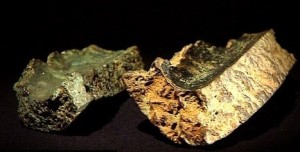 Metal detectorist Simon Richardson has found fragments of 15th century handguns and early lead shot on a War of the Roses battlefield in Yorkshire, north England. He was scanning the site of the 1461 Battle of Towton in collaboration with archaeologists who have been excavating the area for over 10 years.
Metal detectorist Simon Richardson has found fragments of 15th century handguns and early lead shot on a War of the Roses battlefield in Yorkshire, north England. He was scanning the site of the 1461 Battle of Towton in collaboration with archaeologists who have been excavating the area for over 10 years.
The fragments of the gun barrels were made out of 2 different alloys of bronze and thus in all likelihood came from 2 different weapons. It’s eminently possible that they exploded in their shooters’ hands. Because of the poor quality of the castings and the copious bubbles and defects in the metal, early handguns were notoriously unreliable and prone to explosion when fired. The Battle of Towton would have been especially susceptible to exploding handgun failure because it was fought in the middle of a blizzard.
Archaeologists know of no earlier instance of guns being used on a British battlefield, or even a European one for that matter. Last year a pile of lead shot and artillery found at the site of the Battle of Bosworth made headlines because it suggested far more widespread use of firearms in a late medieval battle than was previously known, and Bosworth happened in 1485, almost 25 years after the Battle of Towton.
Experts at the ISIS Research Centre in Oxfordshire, which uses neutron analysis to examine samples in minute detail, said the finds were “unique in Britain”.
[Lead project archaeologist Tim Sutherland] said: “In terms of its rarity, we don’t know of any other battlefield where one of these has turned up.
“In terms of the Towton battlefield, it’s very important because we’re looking at the cusp of the use of archery and the introduction of handguns.
“When we analyse the internal coating, that has the constituent parts of gunpowder. It’s incredibly important and we still can’t believe we’ve found this.”
The bullet found is also of major significance because it’s a lead ball with an iron core, and thus the earliest composite lead bullet ever found in Europe.
Towton was reputed to have been one of the bloodiest battles ever fought on British soil. According to historical sources, in 10 hours of fighting, 28,000 men were killed. The archaeological evidence so far hasn’t borne this out. Tim Sutherland thinks that’s Yorkist propaganda rather than an accurate body count. The team has found several mass graves over the decade and a half they’ve been researching the site, and the numbers found suggest something more along the lines of 3,000 to 4,000 deaths.
The battle was a rout, however, with no quarter given to retreating forces, so bodies would have littered not just the field itself but areas radiating out from it.
Even without the bloody title, Towton remains a pivotal moment in English history. The Yorkist victory was complete enough to put Edward IV on the throne of England.